Coles' Market Expansion: Analysis of India, China, and Strategy
VerifiedAdded on 2022/09/15
|8
|2152
|17
Report
AI Summary
This report analyzes the market expansion strategies of Coles, a major Australian supermarket chain, focusing on the feasibility of entering the Indian and Chinese markets. The analysis evaluates key factors such as political stability, government intervention, disposable income, and customer behavior in both countries. The report highlights the advantages of the Indian market, including its stable political environment, transparent legislative frameworks, and adaptable customer base, making it a more promising option than China. The report suggests a joint venture as the most effective market entry strategy for Coles in India, minimizing risks and leveraging existing market presence. The conclusion recommends that Coles prioritize expansion into the Indian market to capitalize on growth opportunities and achieve increased profitability through lower costs and a receptive customer base. The report references several academic sources to support its findings.
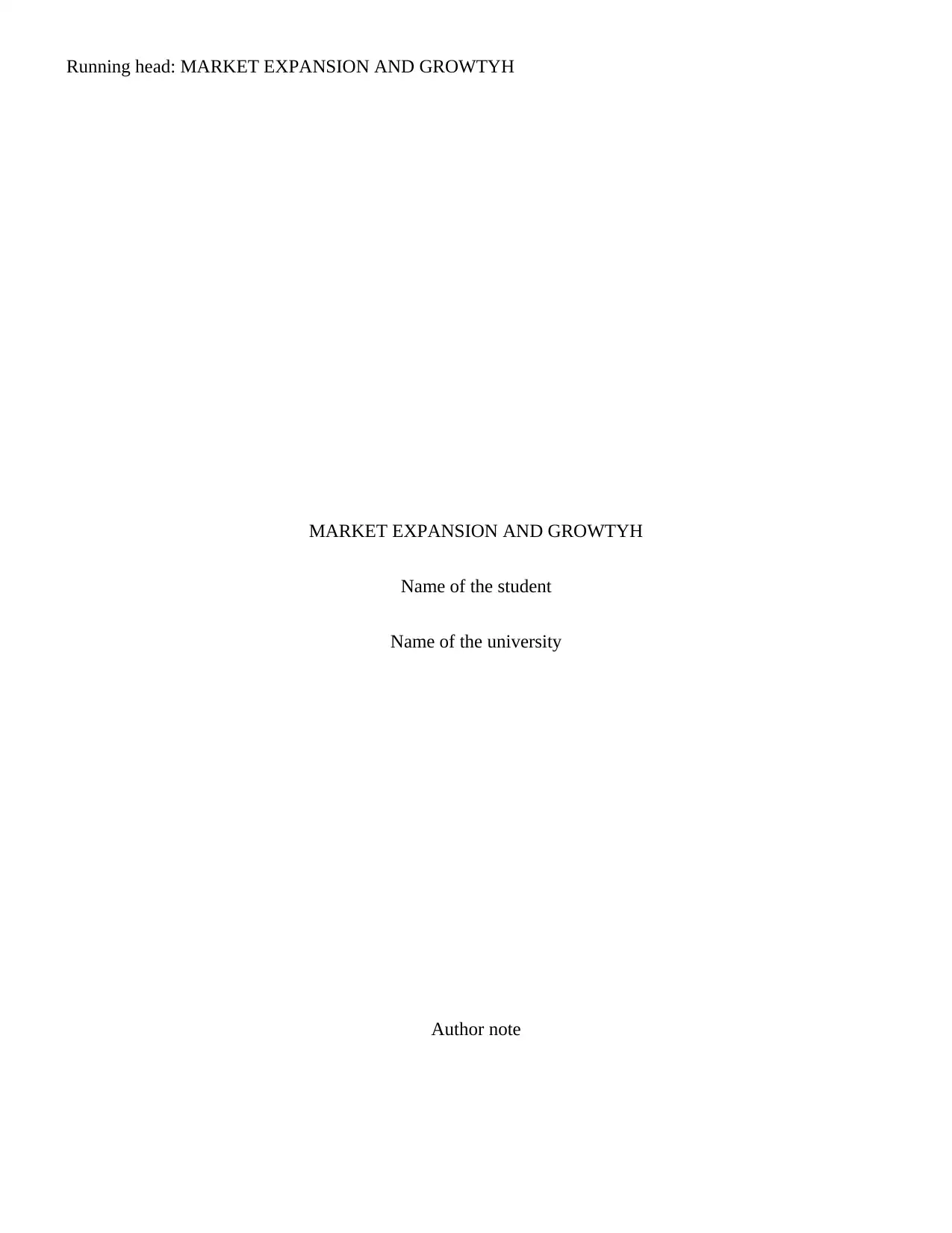
Running head: MARKET EXPANSION AND GROWTYH
MARKET EXPANSION AND GROWTYH
Name of the student
Name of the university
Author note
MARKET EXPANSION AND GROWTYH
Name of the student
Name of the university
Author note
Paraphrase This Document
Need a fresh take? Get an instant paraphrase of this document with our AI Paraphraser
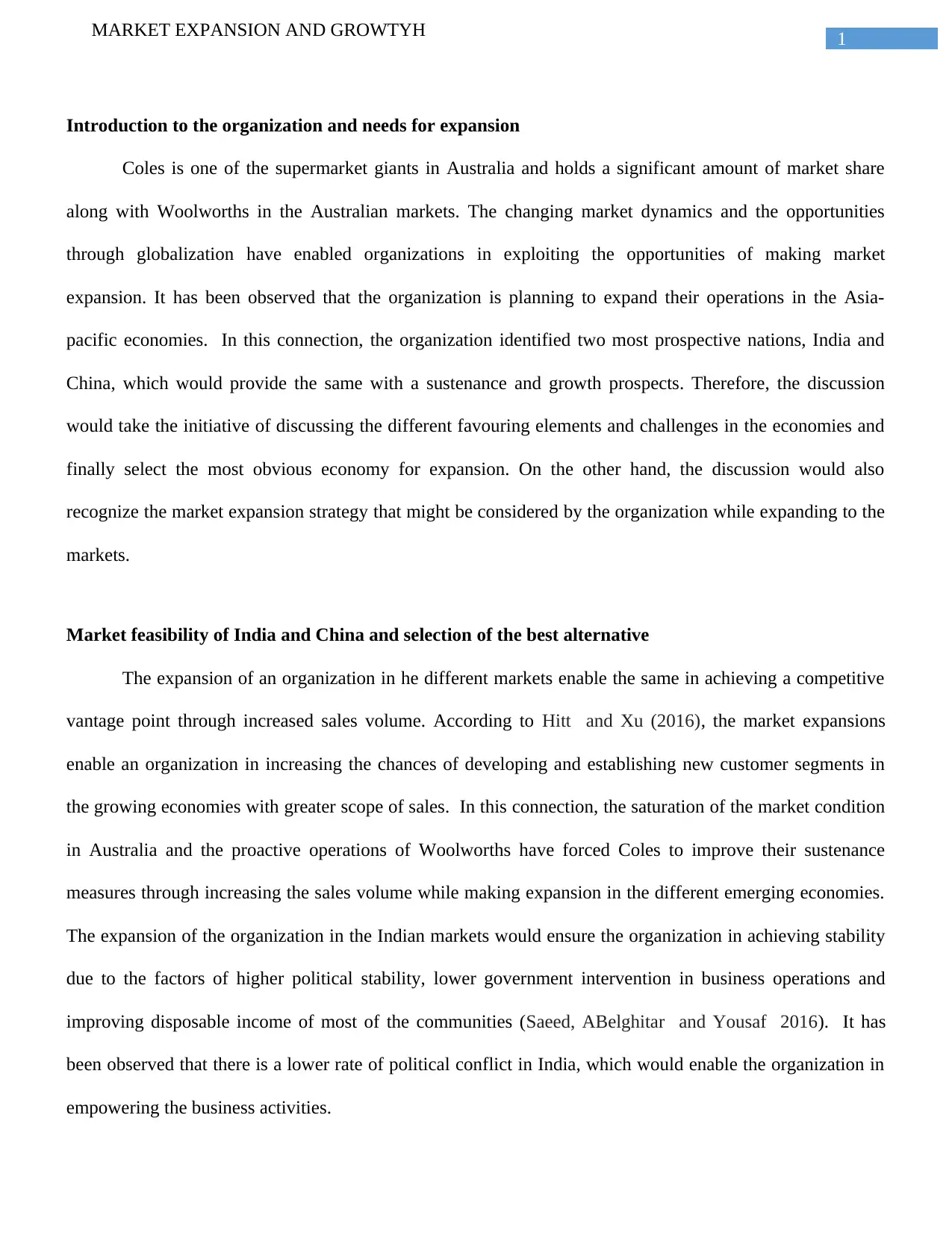
1MARKET EXPANSION AND GROWTYH
Introduction to the organization and needs for expansion
Coles is one of the supermarket giants in Australia and holds a significant amount of market share
along with Woolworths in the Australian markets. The changing market dynamics and the opportunities
through globalization have enabled organizations in exploiting the opportunities of making market
expansion. It has been observed that the organization is planning to expand their operations in the Asia-
pacific economies. In this connection, the organization identified two most prospective nations, India and
China, which would provide the same with a sustenance and growth prospects. Therefore, the discussion
would take the initiative of discussing the different favouring elements and challenges in the economies and
finally select the most obvious economy for expansion. On the other hand, the discussion would also
recognize the market expansion strategy that might be considered by the organization while expanding to the
markets.
Market feasibility of India and China and selection of the best alternative
The expansion of an organization in he different markets enable the same in achieving a competitive
vantage point through increased sales volume. According to Hitt and Xu (2016), the market expansions
enable an organization in increasing the chances of developing and establishing new customer segments in
the growing economies with greater scope of sales. In this connection, the saturation of the market condition
in Australia and the proactive operations of Woolworths have forced Coles to improve their sustenance
measures through increasing the sales volume while making expansion in the different emerging economies.
The expansion of the organization in the Indian markets would ensure the organization in achieving stability
due to the factors of higher political stability, lower government intervention in business operations and
improving disposable income of most of the communities (Saeed, ABelghitar and Yousaf 2016). It has
been observed that there is a lower rate of political conflict in India, which would enable the organization in
empowering the business activities.
Introduction to the organization and needs for expansion
Coles is one of the supermarket giants in Australia and holds a significant amount of market share
along with Woolworths in the Australian markets. The changing market dynamics and the opportunities
through globalization have enabled organizations in exploiting the opportunities of making market
expansion. It has been observed that the organization is planning to expand their operations in the Asia-
pacific economies. In this connection, the organization identified two most prospective nations, India and
China, which would provide the same with a sustenance and growth prospects. Therefore, the discussion
would take the initiative of discussing the different favouring elements and challenges in the economies and
finally select the most obvious economy for expansion. On the other hand, the discussion would also
recognize the market expansion strategy that might be considered by the organization while expanding to the
markets.
Market feasibility of India and China and selection of the best alternative
The expansion of an organization in he different markets enable the same in achieving a competitive
vantage point through increased sales volume. According to Hitt and Xu (2016), the market expansions
enable an organization in increasing the chances of developing and establishing new customer segments in
the growing economies with greater scope of sales. In this connection, the saturation of the market condition
in Australia and the proactive operations of Woolworths have forced Coles to improve their sustenance
measures through increasing the sales volume while making expansion in the different emerging economies.
The expansion of the organization in the Indian markets would ensure the organization in achieving stability
due to the factors of higher political stability, lower government intervention in business operations and
improving disposable income of most of the communities (Saeed, ABelghitar and Yousaf 2016). It has
been observed that there is a lower rate of political conflict in India, which would enable the organization in
empowering the business activities.
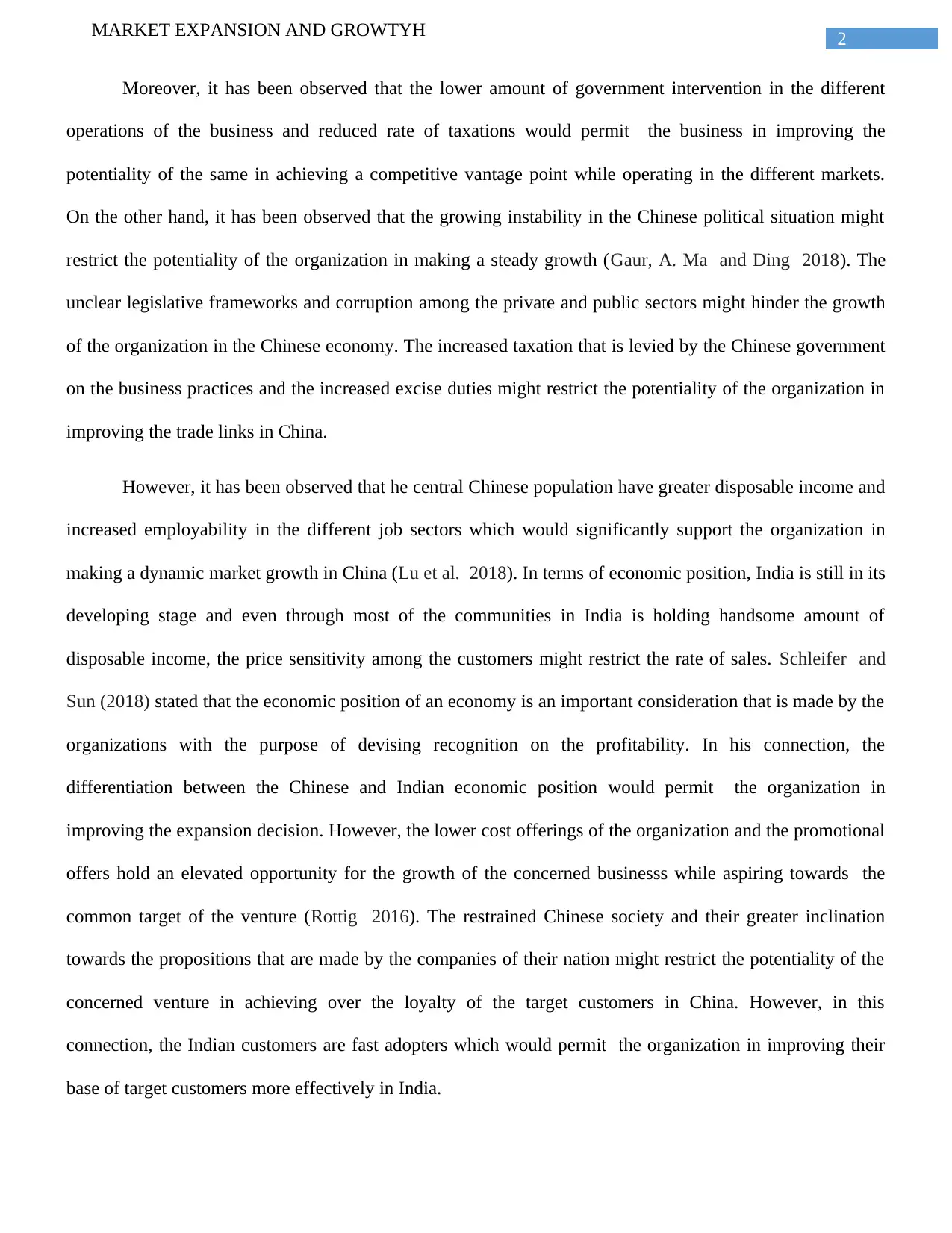
2MARKET EXPANSION AND GROWTYH
Moreover, it has been observed that the lower amount of government intervention in the different
operations of the business and reduced rate of taxations would permit the business in improving the
potentiality of the same in achieving a competitive vantage point while operating in the different markets.
On the other hand, it has been observed that the growing instability in the Chinese political situation might
restrict the potentiality of the organization in making a steady growth (Gaur, A. Ma and Ding 2018). The
unclear legislative frameworks and corruption among the private and public sectors might hinder the growth
of the organization in the Chinese economy. The increased taxation that is levied by the Chinese government
on the business practices and the increased excise duties might restrict the potentiality of the organization in
improving the trade links in China.
However, it has been observed that he central Chinese population have greater disposable income and
increased employability in the different job sectors which would significantly support the organization in
making a dynamic market growth in China (Lu et al. 2018). In terms of economic position, India is still in its
developing stage and even through most of the communities in India is holding handsome amount of
disposable income, the price sensitivity among the customers might restrict the rate of sales. Schleifer and
Sun (2018) stated that the economic position of an economy is an important consideration that is made by the
organizations with the purpose of devising recognition on the profitability. In his connection, the
differentiation between the Chinese and Indian economic position would permit the organization in
improving the expansion decision. However, the lower cost offerings of the organization and the promotional
offers hold an elevated opportunity for the growth of the concerned businesss while aspiring towards the
common target of the venture (Rottig 2016). The restrained Chinese society and their greater inclination
towards the propositions that are made by the companies of their nation might restrict the potentiality of the
concerned venture in achieving over the loyalty of the target customers in China. However, in this
connection, the Indian customers are fast adopters which would permit the organization in improving their
base of target customers more effectively in India.
Moreover, it has been observed that the lower amount of government intervention in the different
operations of the business and reduced rate of taxations would permit the business in improving the
potentiality of the same in achieving a competitive vantage point while operating in the different markets.
On the other hand, it has been observed that the growing instability in the Chinese political situation might
restrict the potentiality of the organization in making a steady growth (Gaur, A. Ma and Ding 2018). The
unclear legislative frameworks and corruption among the private and public sectors might hinder the growth
of the organization in the Chinese economy. The increased taxation that is levied by the Chinese government
on the business practices and the increased excise duties might restrict the potentiality of the organization in
improving the trade links in China.
However, it has been observed that he central Chinese population have greater disposable income and
increased employability in the different job sectors which would significantly support the organization in
making a dynamic market growth in China (Lu et al. 2018). In terms of economic position, India is still in its
developing stage and even through most of the communities in India is holding handsome amount of
disposable income, the price sensitivity among the customers might restrict the rate of sales. Schleifer and
Sun (2018) stated that the economic position of an economy is an important consideration that is made by the
organizations with the purpose of devising recognition on the profitability. In his connection, the
differentiation between the Chinese and Indian economic position would permit the organization in
improving the expansion decision. However, the lower cost offerings of the organization and the promotional
offers hold an elevated opportunity for the growth of the concerned businesss while aspiring towards the
common target of the venture (Rottig 2016). The restrained Chinese society and their greater inclination
towards the propositions that are made by the companies of their nation might restrict the potentiality of the
concerned venture in achieving over the loyalty of the target customers in China. However, in this
connection, the Indian customers are fast adopters which would permit the organization in improving their
base of target customers more effectively in India.
⊘ This is a preview!⊘
Do you want full access?
Subscribe today to unlock all pages.

Trusted by 1+ million students worldwide
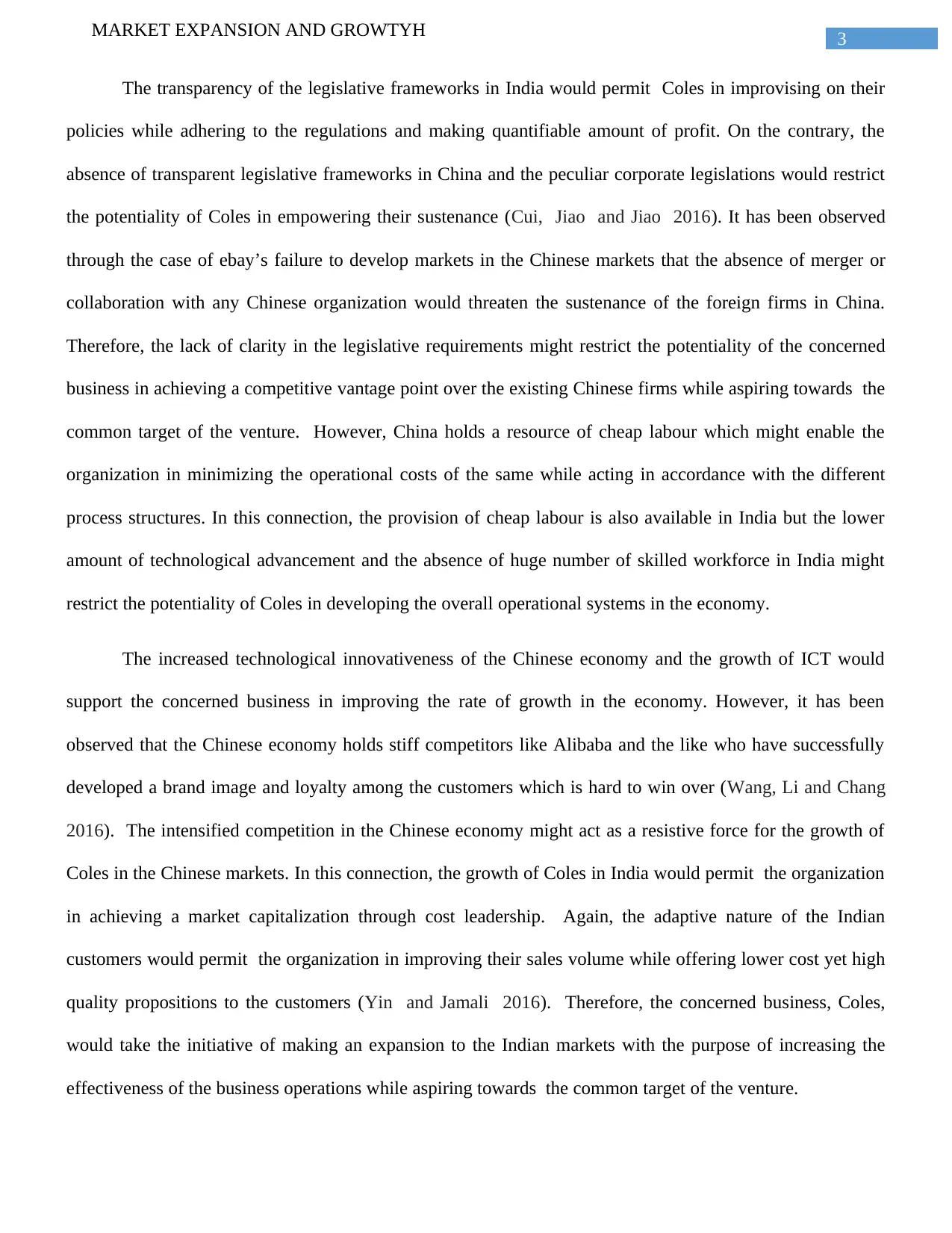
3MARKET EXPANSION AND GROWTYH
The transparency of the legislative frameworks in India would permit Coles in improvising on their
policies while adhering to the regulations and making quantifiable amount of profit. On the contrary, the
absence of transparent legislative frameworks in China and the peculiar corporate legislations would restrict
the potentiality of Coles in empowering their sustenance (Cui, Jiao and Jiao 2016). It has been observed
through the case of ebay’s failure to develop markets in the Chinese markets that the absence of merger or
collaboration with any Chinese organization would threaten the sustenance of the foreign firms in China.
Therefore, the lack of clarity in the legislative requirements might restrict the potentiality of the concerned
business in achieving a competitive vantage point over the existing Chinese firms while aspiring towards the
common target of the venture. However, China holds a resource of cheap labour which might enable the
organization in minimizing the operational costs of the same while acting in accordance with the different
process structures. In this connection, the provision of cheap labour is also available in India but the lower
amount of technological advancement and the absence of huge number of skilled workforce in India might
restrict the potentiality of Coles in developing the overall operational systems in the economy.
The increased technological innovativeness of the Chinese economy and the growth of ICT would
support the concerned business in improving the rate of growth in the economy. However, it has been
observed that the Chinese economy holds stiff competitors like Alibaba and the like who have successfully
developed a brand image and loyalty among the customers which is hard to win over (Wang, Li and Chang
2016). The intensified competition in the Chinese economy might act as a resistive force for the growth of
Coles in the Chinese markets. In this connection, the growth of Coles in India would permit the organization
in achieving a market capitalization through cost leadership. Again, the adaptive nature of the Indian
customers would permit the organization in improving their sales volume while offering lower cost yet high
quality propositions to the customers (Yin and Jamali 2016). Therefore, the concerned business, Coles,
would take the initiative of making an expansion to the Indian markets with the purpose of increasing the
effectiveness of the business operations while aspiring towards the common target of the venture.
The transparency of the legislative frameworks in India would permit Coles in improvising on their
policies while adhering to the regulations and making quantifiable amount of profit. On the contrary, the
absence of transparent legislative frameworks in China and the peculiar corporate legislations would restrict
the potentiality of Coles in empowering their sustenance (Cui, Jiao and Jiao 2016). It has been observed
through the case of ebay’s failure to develop markets in the Chinese markets that the absence of merger or
collaboration with any Chinese organization would threaten the sustenance of the foreign firms in China.
Therefore, the lack of clarity in the legislative requirements might restrict the potentiality of the concerned
business in achieving a competitive vantage point over the existing Chinese firms while aspiring towards the
common target of the venture. However, China holds a resource of cheap labour which might enable the
organization in minimizing the operational costs of the same while acting in accordance with the different
process structures. In this connection, the provision of cheap labour is also available in India but the lower
amount of technological advancement and the absence of huge number of skilled workforce in India might
restrict the potentiality of Coles in developing the overall operational systems in the economy.
The increased technological innovativeness of the Chinese economy and the growth of ICT would
support the concerned business in improving the rate of growth in the economy. However, it has been
observed that the Chinese economy holds stiff competitors like Alibaba and the like who have successfully
developed a brand image and loyalty among the customers which is hard to win over (Wang, Li and Chang
2016). The intensified competition in the Chinese economy might act as a resistive force for the growth of
Coles in the Chinese markets. In this connection, the growth of Coles in India would permit the organization
in achieving a market capitalization through cost leadership. Again, the adaptive nature of the Indian
customers would permit the organization in improving their sales volume while offering lower cost yet high
quality propositions to the customers (Yin and Jamali 2016). Therefore, the concerned business, Coles,
would take the initiative of making an expansion to the Indian markets with the purpose of increasing the
effectiveness of the business operations while aspiring towards the common target of the venture.
Paraphrase This Document
Need a fresh take? Get an instant paraphrase of this document with our AI Paraphraser
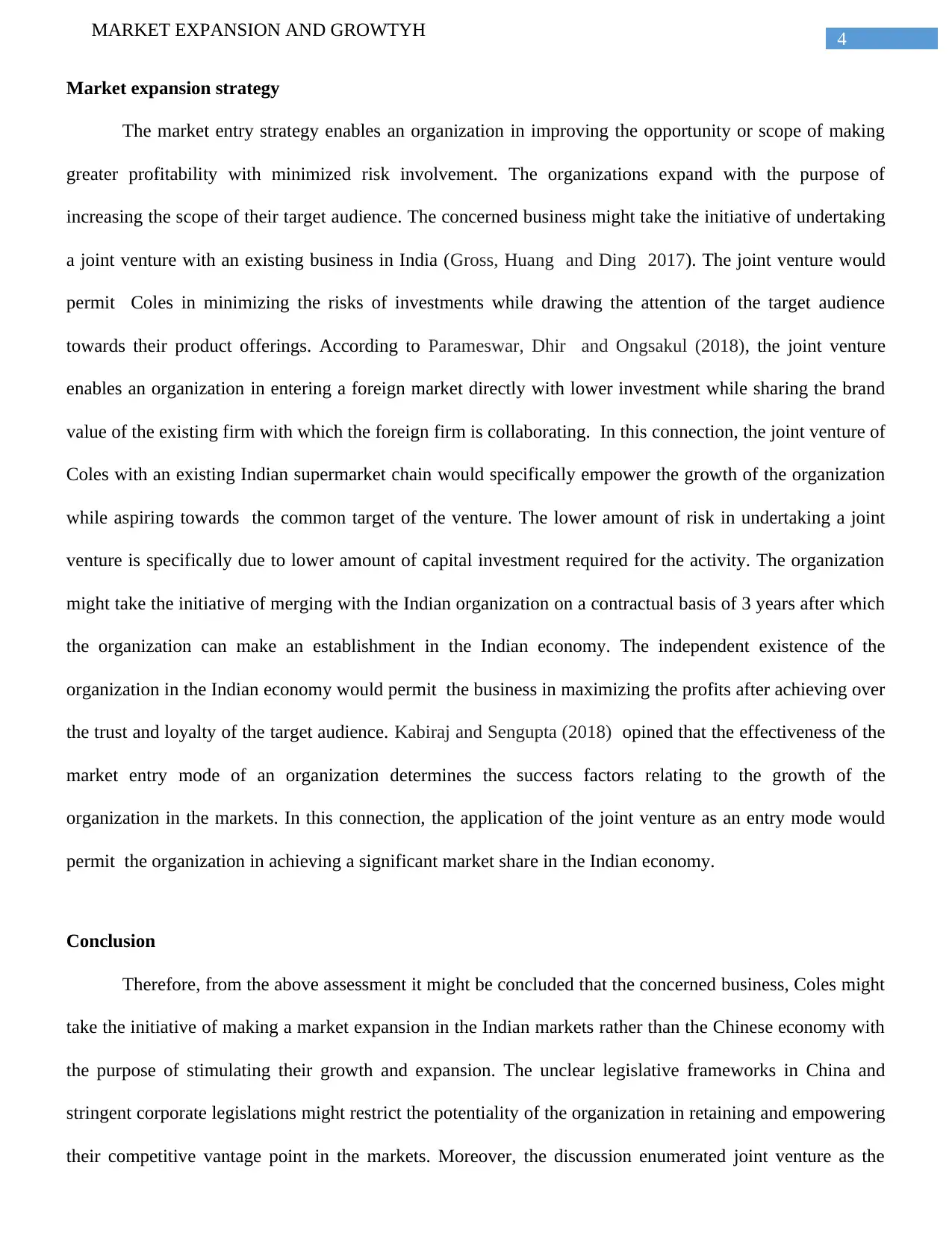
4MARKET EXPANSION AND GROWTYH
Market expansion strategy
The market entry strategy enables an organization in improving the opportunity or scope of making
greater profitability with minimized risk involvement. The organizations expand with the purpose of
increasing the scope of their target audience. The concerned business might take the initiative of undertaking
a joint venture with an existing business in India (Gross, Huang and Ding 2017). The joint venture would
permit Coles in minimizing the risks of investments while drawing the attention of the target audience
towards their product offerings. According to Parameswar, Dhir and Ongsakul (2018), the joint venture
enables an organization in entering a foreign market directly with lower investment while sharing the brand
value of the existing firm with which the foreign firm is collaborating. In this connection, the joint venture of
Coles with an existing Indian supermarket chain would specifically empower the growth of the organization
while aspiring towards the common target of the venture. The lower amount of risk in undertaking a joint
venture is specifically due to lower amount of capital investment required for the activity. The organization
might take the initiative of merging with the Indian organization on a contractual basis of 3 years after which
the organization can make an establishment in the Indian economy. The independent existence of the
organization in the Indian economy would permit the business in maximizing the profits after achieving over
the trust and loyalty of the target audience. Kabiraj and Sengupta (2018) opined that the effectiveness of the
market entry mode of an organization determines the success factors relating to the growth of the
organization in the markets. In this connection, the application of the joint venture as an entry mode would
permit the organization in achieving a significant market share in the Indian economy.
Conclusion
Therefore, from the above assessment it might be concluded that the concerned business, Coles might
take the initiative of making a market expansion in the Indian markets rather than the Chinese economy with
the purpose of stimulating their growth and expansion. The unclear legislative frameworks in China and
stringent corporate legislations might restrict the potentiality of the organization in retaining and empowering
their competitive vantage point in the markets. Moreover, the discussion enumerated joint venture as the
Market expansion strategy
The market entry strategy enables an organization in improving the opportunity or scope of making
greater profitability with minimized risk involvement. The organizations expand with the purpose of
increasing the scope of their target audience. The concerned business might take the initiative of undertaking
a joint venture with an existing business in India (Gross, Huang and Ding 2017). The joint venture would
permit Coles in minimizing the risks of investments while drawing the attention of the target audience
towards their product offerings. According to Parameswar, Dhir and Ongsakul (2018), the joint venture
enables an organization in entering a foreign market directly with lower investment while sharing the brand
value of the existing firm with which the foreign firm is collaborating. In this connection, the joint venture of
Coles with an existing Indian supermarket chain would specifically empower the growth of the organization
while aspiring towards the common target of the venture. The lower amount of risk in undertaking a joint
venture is specifically due to lower amount of capital investment required for the activity. The organization
might take the initiative of merging with the Indian organization on a contractual basis of 3 years after which
the organization can make an establishment in the Indian economy. The independent existence of the
organization in the Indian economy would permit the business in maximizing the profits after achieving over
the trust and loyalty of the target audience. Kabiraj and Sengupta (2018) opined that the effectiveness of the
market entry mode of an organization determines the success factors relating to the growth of the
organization in the markets. In this connection, the application of the joint venture as an entry mode would
permit the organization in achieving a significant market share in the Indian economy.
Conclusion
Therefore, from the above assessment it might be concluded that the concerned business, Coles might
take the initiative of making a market expansion in the Indian markets rather than the Chinese economy with
the purpose of stimulating their growth and expansion. The unclear legislative frameworks in China and
stringent corporate legislations might restrict the potentiality of the organization in retaining and empowering
their competitive vantage point in the markets. Moreover, the discussion enumerated joint venture as the
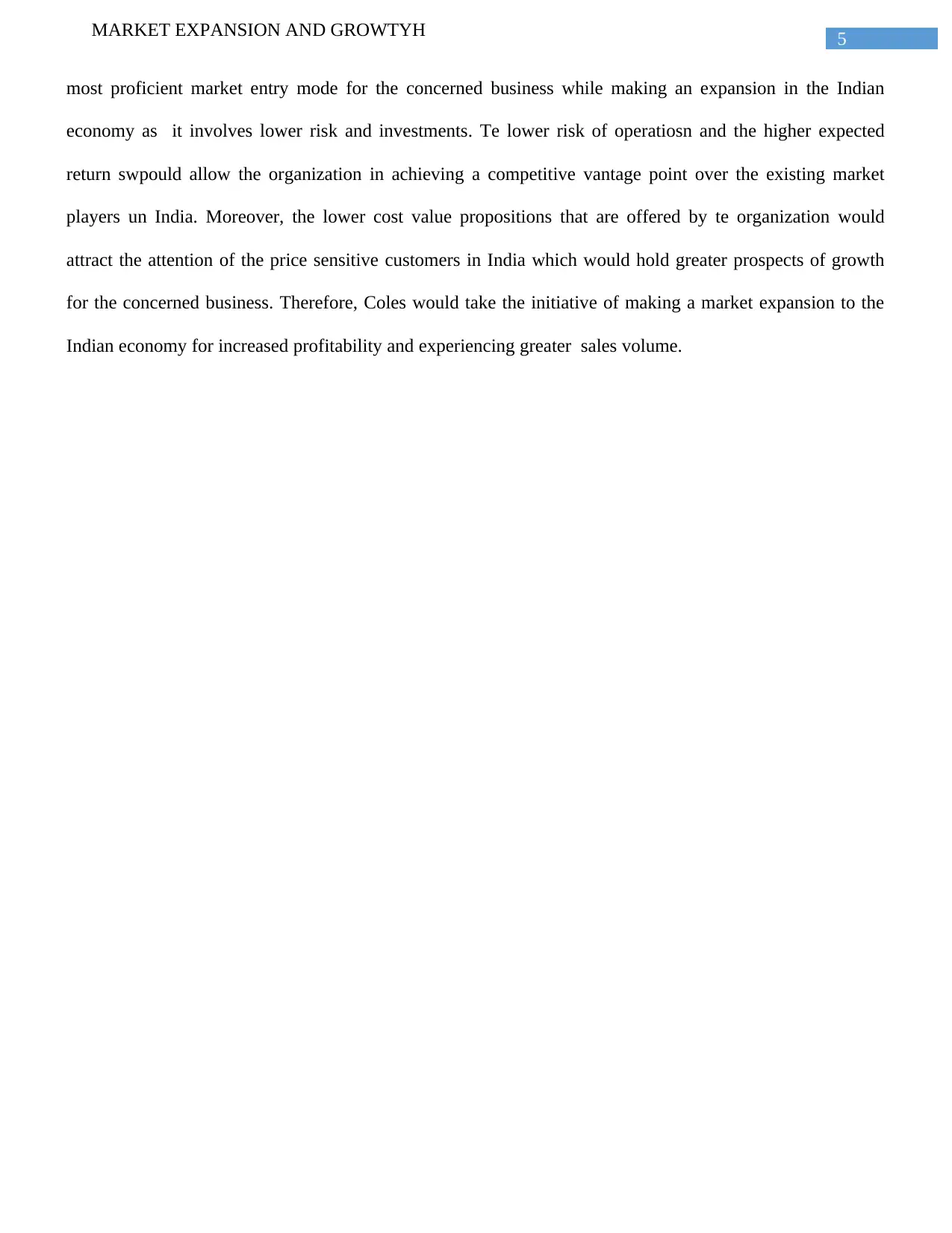
5MARKET EXPANSION AND GROWTYH
most proficient market entry mode for the concerned business while making an expansion in the Indian
economy as it involves lower risk and investments. Te lower risk of operatiosn and the higher expected
return swpould allow the organization in achieving a competitive vantage point over the existing market
players un India. Moreover, the lower cost value propositions that are offered by te organization would
attract the attention of the price sensitive customers in India which would hold greater prospects of growth
for the concerned business. Therefore, Coles would take the initiative of making a market expansion to the
Indian economy for increased profitability and experiencing greater sales volume.
most proficient market entry mode for the concerned business while making an expansion in the Indian
economy as it involves lower risk and investments. Te lower risk of operatiosn and the higher expected
return swpould allow the organization in achieving a competitive vantage point over the existing market
players un India. Moreover, the lower cost value propositions that are offered by te organization would
attract the attention of the price sensitive customers in India which would hold greater prospects of growth
for the concerned business. Therefore, Coles would take the initiative of making a market expansion to the
Indian economy for increased profitability and experiencing greater sales volume.
⊘ This is a preview!⊘
Do you want full access?
Subscribe today to unlock all pages.

Trusted by 1+ million students worldwide
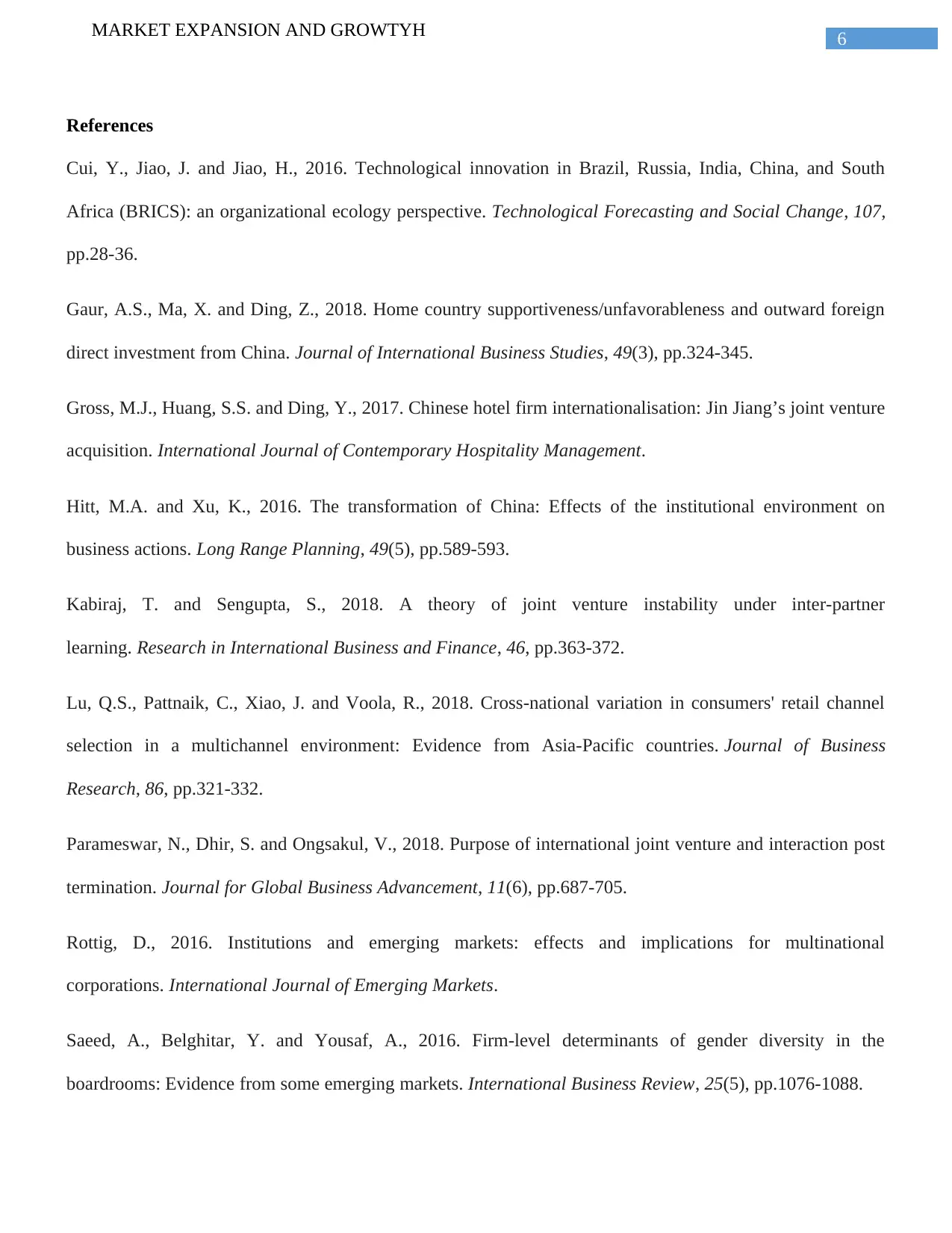
6MARKET EXPANSION AND GROWTYH
References
Cui, Y., Jiao, J. and Jiao, H., 2016. Technological innovation in Brazil, Russia, India, China, and South
Africa (BRICS): an organizational ecology perspective. Technological Forecasting and Social Change, 107,
pp.28-36.
Gaur, A.S., Ma, X. and Ding, Z., 2018. Home country supportiveness/unfavorableness and outward foreign
direct investment from China. Journal of International Business Studies, 49(3), pp.324-345.
Gross, M.J., Huang, S.S. and Ding, Y., 2017. Chinese hotel firm internationalisation: Jin Jiang’s joint venture
acquisition. International Journal of Contemporary Hospitality Management.
Hitt, M.A. and Xu, K., 2016. The transformation of China: Effects of the institutional environment on
business actions. Long Range Planning, 49(5), pp.589-593.
Kabiraj, T. and Sengupta, S., 2018. A theory of joint venture instability under inter-partner
learning. Research in International Business and Finance, 46, pp.363-372.
Lu, Q.S., Pattnaik, C., Xiao, J. and Voola, R., 2018. Cross-national variation in consumers' retail channel
selection in a multichannel environment: Evidence from Asia-Pacific countries. Journal of Business
Research, 86, pp.321-332.
Parameswar, N., Dhir, S. and Ongsakul, V., 2018. Purpose of international joint venture and interaction post
termination. Journal for Global Business Advancement, 11(6), pp.687-705.
Rottig, D., 2016. Institutions and emerging markets: effects and implications for multinational
corporations. International Journal of Emerging Markets.
Saeed, A., Belghitar, Y. and Yousaf, A., 2016. Firm-level determinants of gender diversity in the
boardrooms: Evidence from some emerging markets. International Business Review, 25(5), pp.1076-1088.
References
Cui, Y., Jiao, J. and Jiao, H., 2016. Technological innovation in Brazil, Russia, India, China, and South
Africa (BRICS): an organizational ecology perspective. Technological Forecasting and Social Change, 107,
pp.28-36.
Gaur, A.S., Ma, X. and Ding, Z., 2018. Home country supportiveness/unfavorableness and outward foreign
direct investment from China. Journal of International Business Studies, 49(3), pp.324-345.
Gross, M.J., Huang, S.S. and Ding, Y., 2017. Chinese hotel firm internationalisation: Jin Jiang’s joint venture
acquisition. International Journal of Contemporary Hospitality Management.
Hitt, M.A. and Xu, K., 2016. The transformation of China: Effects of the institutional environment on
business actions. Long Range Planning, 49(5), pp.589-593.
Kabiraj, T. and Sengupta, S., 2018. A theory of joint venture instability under inter-partner
learning. Research in International Business and Finance, 46, pp.363-372.
Lu, Q.S., Pattnaik, C., Xiao, J. and Voola, R., 2018. Cross-national variation in consumers' retail channel
selection in a multichannel environment: Evidence from Asia-Pacific countries. Journal of Business
Research, 86, pp.321-332.
Parameswar, N., Dhir, S. and Ongsakul, V., 2018. Purpose of international joint venture and interaction post
termination. Journal for Global Business Advancement, 11(6), pp.687-705.
Rottig, D., 2016. Institutions and emerging markets: effects and implications for multinational
corporations. International Journal of Emerging Markets.
Saeed, A., Belghitar, Y. and Yousaf, A., 2016. Firm-level determinants of gender diversity in the
boardrooms: Evidence from some emerging markets. International Business Review, 25(5), pp.1076-1088.
Paraphrase This Document
Need a fresh take? Get an instant paraphrase of this document with our AI Paraphraser
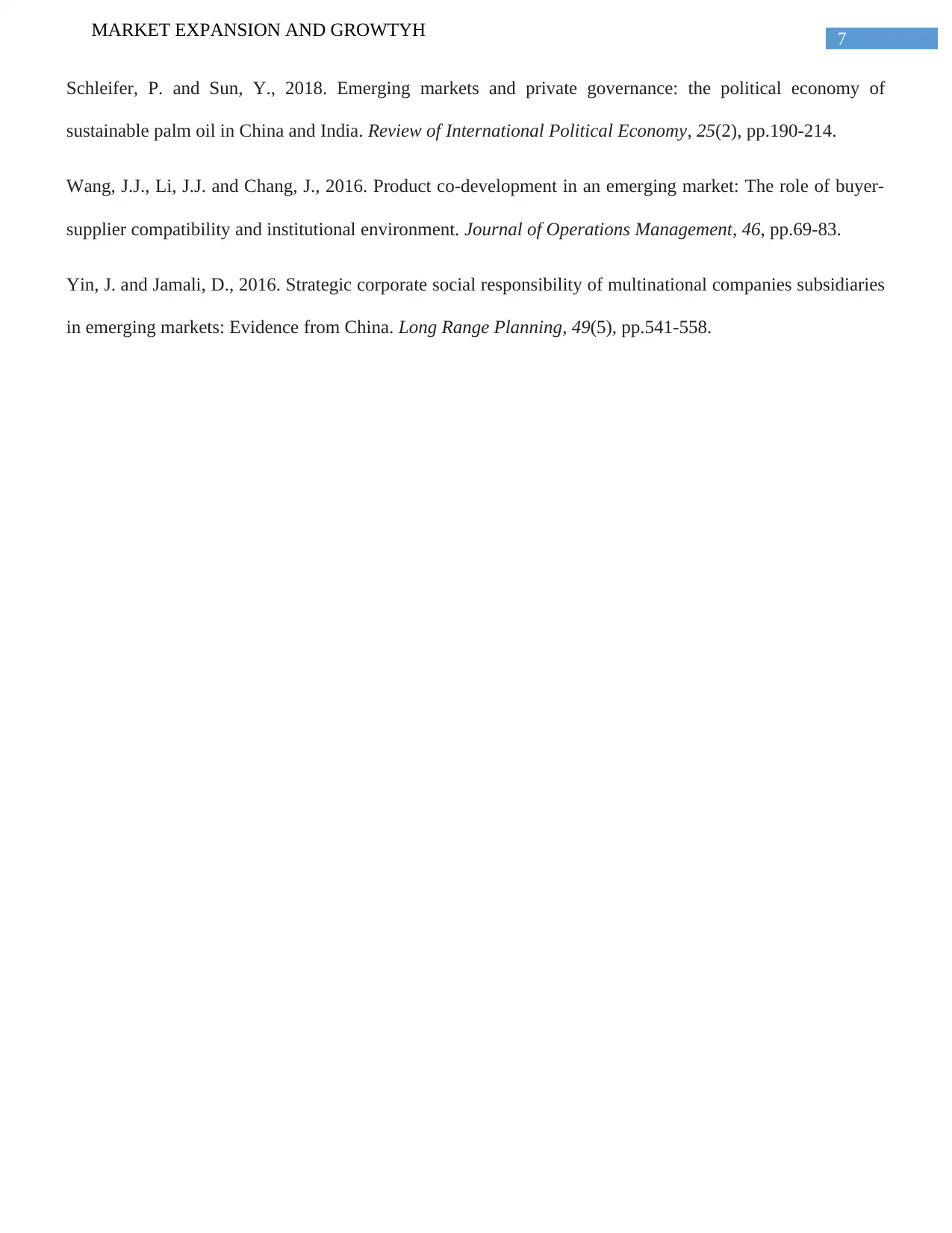
7MARKET EXPANSION AND GROWTYH
Schleifer, P. and Sun, Y., 2018. Emerging markets and private governance: the political economy of
sustainable palm oil in China and India. Review of International Political Economy, 25(2), pp.190-214.
Wang, J.J., Li, J.J. and Chang, J., 2016. Product co-development in an emerging market: The role of buyer-
supplier compatibility and institutional environment. Journal of Operations Management, 46, pp.69-83.
Yin, J. and Jamali, D., 2016. Strategic corporate social responsibility of multinational companies subsidiaries
in emerging markets: Evidence from China. Long Range Planning, 49(5), pp.541-558.
Schleifer, P. and Sun, Y., 2018. Emerging markets and private governance: the political economy of
sustainable palm oil in China and India. Review of International Political Economy, 25(2), pp.190-214.
Wang, J.J., Li, J.J. and Chang, J., 2016. Product co-development in an emerging market: The role of buyer-
supplier compatibility and institutional environment. Journal of Operations Management, 46, pp.69-83.
Yin, J. and Jamali, D., 2016. Strategic corporate social responsibility of multinational companies subsidiaries
in emerging markets: Evidence from China. Long Range Planning, 49(5), pp.541-558.
1 out of 8
Related Documents
Your All-in-One AI-Powered Toolkit for Academic Success.
+13062052269
info@desklib.com
Available 24*7 on WhatsApp / Email
![[object Object]](/_next/static/media/star-bottom.7253800d.svg)
Unlock your academic potential
Copyright © 2020–2025 A2Z Services. All Rights Reserved. Developed and managed by ZUCOL.





